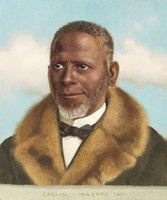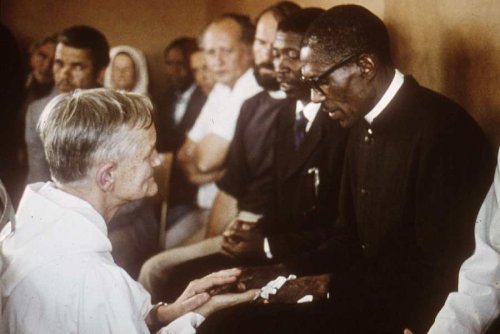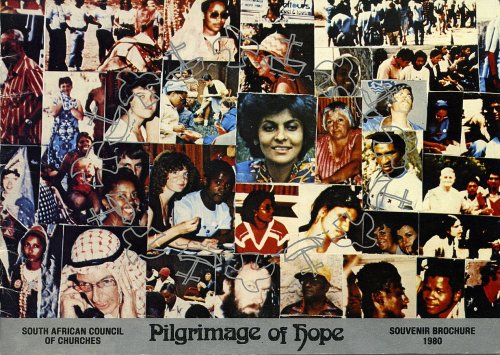Every year dozens of South Africans stay in Taizé and participate in international meetings. Today it is several generations who have been able to experience the common prayer and fraternity lived with the community, a parable of communion. Brother Roger himself was always very attentive to their presence because of the long trial of apartheid that their country was going through, but more personally because he was still marked by a family event which he was fond to recall (“Freshness of a source”, written with Mother Teresa, in chapter 13).
Pastor Calvin Mapopé, from the southern region of Africa, visited the Schutz family in 1925 and was asked before departing to bless each of the children. “As I was the youngest, I was blessed last”, and brother Roger continues, “Since that day my mother has been telling us, ‘faith is disappearing from Europe, but it will be brought back to us in its original freshness by Christians from the South, Africans for example.”

Portrait of Revd Calvin Mapopé, 1925, Lausanne, Hermitage Foundation.
The presence of South Africans in Taizé dates back to the 1960s. One of the first was probably theologian and specialist of Dietrich Bonhoeffer John de Gruchy. He recalls: “My first visit to Taizé took place in 1964, I had heard about Taizé while I was studying in Chicago the year before. I wrote and was invited to come for a week. It seems to me that I was the first South African to have that experience. I had taken the train from Geneva and I still remember climbing the hill to the old door of the monastery near the village church. I did not have a specific expectation or program in mind, but everything was decided by the Dutch brother who took care of my schedule and told me that I would make a retreat in silence, which had never happened to me before. At that time there were few visitors and youth meetings had not started yet. I participated in daily prayers, took my meals in silence, read the rule of Taizé several times as well as books of Brother Roger and Brother Max and I took long walks in the countryside. Until then, I had never heard of Taizé’s music or experienced personal confession, they were experiences that shaped my life.”

John de Gruchy in July 2017 with brothers Norbert and Luc in his study at Voloed
At the end of November 1978, coming from Nairobi, Brother Roger with br Alois and br John spent a few days in South Africa, Johannesburg and Cape Town. In Cape Town, a prayer meeting takes place in Noxolo, the school at the heart of Cross Road, a squatter camp where more than 20,000 Africans lived. The brothers were welcomed by Reverend Kani, other pastors and the Mayor of Cross Roads. Sister Thérèse-Pascale of Jesus wrote in their diary of the year: “As the song continues, brother Roger kneels in front of each person, the old, the young, the little children, asking everyone to make a sign of the Cross in the palm of his hand, as a gesture of forgiveness that he would like to bring back to young people in Europe. People take this very seriously, making the sign of the cross with great respect. Then the brothers are received by Fr Basil at Holy Cross, in the District Six which was undergoing a dramatic destruction. In Johannesburg, meetings and visits took place in Soweto. The brothers visited Bayers Naude, who was under house arrest and met Desmond Tutu, recently elected Bishop of Lesotho and Secretary General of the Council of Churches of South Africa.

Brother Roger, Crossroads, 1978

In 1979 Desmond Tutu visited Taizé. He noted this memory: “As I worshipped in the Church of Reconciliation surrounded by 5,000 young people from different quarters of our globe, what I can only believe to have been a divinely inspired vision was vouchafed to me – would it not be wonderful if a pilgrimage of young South Africans of all races could come together to Taizé to worship, to laugh, to love, to rough it together as a sign of our faith in a nonracial South Africa? I was given the number – 144 from the 144,000 of the blessed in Revelation 7.”
This visit to Taizé of 144 young South Africans of all races of the country and 20 different churches took place in July 1980. Bishop Tutu who prepared this pilgrimage could not participate because his passport was confiscated. Bishop Bruce Evans accompanied the group. In a “Message to the People of South Africa” written in Taizé on July 19th, 1980, the participants declare that “our group of young people of all races and Christian traditions has testified to the lie of the ideology of apartheid, which claims that we can never live together. Our hope is rooted in the words of Saint Paul ‘There is neither Jew nor Greek, there is neither slave nor free man, there is neither man nor woman’, He has broken all the barriers that separate us from God and from one another and he has called us to a new society, based on love, justice, sharing and great respect for the image of God in each person”. “For us, this experience must have an influence and an impact for the rest of our lives”, says a pilgrim.

Cover of the souvenir booklet of the pilgrimage of hope of 144 young South Africans, 1980
In 1995, a year after the first multiracial elections in the country and the accession of Nelson Mandela to the presidency, the community responded to an invitation from the Churches and facilitate an international meeting in Johannesburg. Brothers spent several months there preparing. Several thousands of young people from all over the country, from neighboring countries and beyond came together from 5 to 7 May 1995. Brother Roger took part. President Mandela addressed the participants in a message: “For some time, the whole world has been looking to South Africa and what we are building here has an impact far beyond the borders of our country. I encourage young people to accept responsibility and not give in to impatience and despair. Thus this generation can be a ferment of hope for many young people around the world who are looking for ways to build trust in the human family. By supporting and serving one another, we can move forward together, finding strength and joy in the solidarity that unites us.”
After Nairobi (2008), Kigali (2012) and Cotonou (2016), from 25 to 29 September 2019 the Cape Town meeting was a new African stage of the pilgrimage of trust.
 TAIZÉ
TAIZÉ